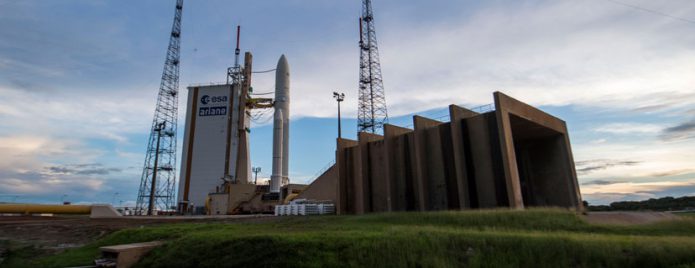Dual-payload delivery: Ariane 5 sends SGDC and KOREASAT-7 to geostationary transfer orbit

Ariane 5 is shown ready for its evening liftoff from the Spaceport on Flight VA236, which deployed the SGDC and KOREASAT-7 satellite passengers.
Arianespace orbited two telecommunications payloads for Brazil and South Korea on the 78th consecutive success performed with its Ariane 5 – confirming this vehicle’s position as the world reference for heavy launchers.
Lifting off from the Spaceport in French Guiana, today’s mission – designated Flight VA236 in Arianespace’s numbering system – delivered an estimated payload lift performance of 10,289 kg. to geostationary transfer orbit.
It carried SGDC (Geostationary Satellite for Communications and Defense) for VISIONA Tecnologia Espacial S.A. (on behalf of Brazilian operator Telebras S.A. and the Brazilian government); and KOREASAT-7, which will be operated by ktsat – a wholly-owned subsidiary of South Korea’s KT Corp. SGDC was deployed first in the flight sequence, separating from Ariane 5 at 28 minutes after liftoff, followed 8 minutes later by KOREASAT-7.
Both SGDC and KOREASAT-7 were produced by Thales Alenia Space using its Spacebus satellite platforms (Spacebus 4000C4 for SGDC; Spacebus 4000B2 for KOREASAT-7). This marks the seventh time Arianespace has performed a dual-payload flight with both satellites built by this spacecraft manufacturer.
Arianespace CEO Stéphane Israël offered his congratulations to all parties involved during post-launch comments from the Spaceport’s Jupiter control room, and added that Flight VA236 “served two special customers and countries.”
The VA236 mission success was recognized by Rémy Le Thuc, Thales Alenia Space’s Telecommunications Projects Vice President, who added: “Thanks to Stéphane Israël and the Arianespace team. Ariane 5 operated like clockwork, as usual, which is definitely due to your team’s know-how and skill. Great job!”
Providing relay capacity for South America
SGDC is the first satellite Arianespace has launched for Telebras S.A., performed within the framework of a contract with SGDC prime contractor VISIONA Tecnologia Espacial S.A.
It will operate from an orbital position of 75 deg. West with Ka- and X-band transponders, providing sovereign and secure means for Brazilian government and defense strategic communications, as well as high-quality Internet services to 100 percent of the Brazilian territory as part of the National Broadband Plan.
Meeting increased demand for services in Asia
KOREASAT-7 is the third KOREASAT satellite orbited by Arianespace for ktsat, following KOREASAT-3 and KOREASAT-6 – launched in September 1999 and December 2010, respectively.
When located at the 116 deg. East orbital slot, KOREASAT-7 will be used for a full range of video and data applications, including internet access, DTH (direct-to-home broadcasting), government communications and connectivity for VSAT (Very Small Aperture Terminal) networks. Its coverage area encompasses Korea, the Philippines, the Indochinese Peninsula, India and Indonesia.
Arianespace’s 2017 launch schedule is on track
“With our fourth successful launch of the year, and the second with an Ariane 5, Arianespace is on track to deliver 12 launches this year as originally scheduled,” added Arianespace’s Israël.
All three members of Arianespace’s launcher family have been utilized so far in 2017 to loft payloads for the company’s clients. In addition to the previous Ariane 5 mission (Flight VA235 with SKY Brasil-1 and Telkom 3S, conducted in February), the medium-lift Soyuz was in action during January to orbit Hispasat 36W-1, and the lightweight Vega lofted Sentinel-2B in March.








